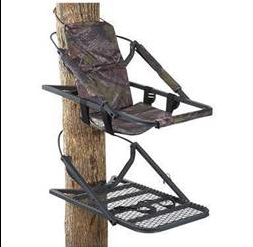Tree stand accidents occur frequently during hunting season, causing a variety of injuries from broken bones to paralysis and death. Tree stand accidents involve a variety of causes, including falls from the tree stand, collapse of the tree stand, fires, self inflicted gunshot wounds, and asphyxiation. A study by the Center for Disease Control examined hunting accidents from 1979-1989. 214 of 594 deer hunting related accidents involved tree stands. 52% of these tree stand accidents were due to falls from the stand, 32% were due to collapse of the tree stands.
Collapse of Tree Stands
Collapse of tree stands occur due to a variety of reasons. Improper set-up of the tree stand can lead to collapse of the tree stand or falling from the tree stand. Improper set-up can include failing to adequately secure the tree stand to the tree, not properly securing the components of the tree stand, and failing to use the restraint system.
Tree stands also can collapse due to design or manufacturing defects of the tree stand. The collapse of many tree stands occurs due to failure in the system that secures the tree stand to the tree. Different designs utilize either some sort of webbing or strap, or a structural frame that engages the tree. The webbing or straps that secure the stand to the tree can fail due to design defects that allow the webbing to run across sharp surfaces. Buckles, hooks, or other devices that secure the webbing to the tree stand can fail due to inadequate design of the buckle that leads to failure, or design defects that allow the attachment connection to become disengaged under certain circumstances, such as when a force in a specific direction is applied to the bracket. Hooks are particularly susceptible to accidental disengagement. Collapse of a tree stand can also occur due to catastrophic failure of other structural components.

Tree stand recalled for suspension defect
Hanging vs. Climber Tree Stands
Basic tree stands are only designed to be suspended from a tree, so the hunter must first ascend to the height that he wants the tree stand to be at, using various ascension methods. Some climbing stands incorporate a method to ascend the tree into the tree stand. These climbing stands involve numerous moving mechanical components and attachment points, the failure of which may cause the tree stand to fall or the user to lose their balance and fall.
Falls from Tree Stands
Falls from tree stands occur frequently due to a variety of contributing factors most of which are not tree stand related. Protecting tree stand users from falls is accomplished by using safety restraint systems. These harnesses can utilize a waist belt, leg loops, or a full body harness. These harnesses are then integrated into a fall protection system, usually involving a safety line, with some systems incorporating means to safely ascend to or descend from the tree stand.

Climbing tree stand
Controversy over Safety Restraints
There was a push in 2002 to ban the use of safety restraints from tree stands. This was part of a petition to the CPSC to produce a safety standard regarding tree stands. This petition cited examples of hunters who asphyxiated from hanging in their harnesses. Hanging in harnesses for prolonged periods, especially if unconscious, can result in death. This phenomenon is referred to as orthostatic incompetence, which refers to the pooling of blood in the legs when the legs are not moving. This is what causes military personnel standing at attention for extended periods of time to pass out-once horizontal the heart can recirculate the pooled blood. People hanging in a harness may not be able to unpool the accumulated blood, since unconsciousness would not change the body position.
Standards
The Treestand Manufacturer's Association has produced safety standards for tree stands, with assistance with the CPSC and other agencies. Mechanical and Safety Engineering can test tree stands to determine compliance with these standards. The following standards relate to various aspects of tree stand safety and design:
ASTM F2120 Practice for Testing Treestand Load Capacity
ASTM F2121 Practice for Treestand Labels
ASTM 2122 Practice for Treestand Safety Devices
ASTM 2123 Practice for Treestand Instructions
ASTM F2124 Practice for Testing Ladder, Tripod and Climbing Stick Load Capacity
ASTM F2125 Test Method for Treestand Adherence Static Stability
ASTM F2126 Test Method for Treestand Static Load
ASTM F2128 Test Method for Treestand Repetitive Loading
ASTM F2275 Practice for Treestand Manufacturer Quality Assurance Program
ASTM F2531 Test Method for the Load Capacity of Treestand Seats
ASTM F2237 Test Method for Treestand Fall Arrest System













